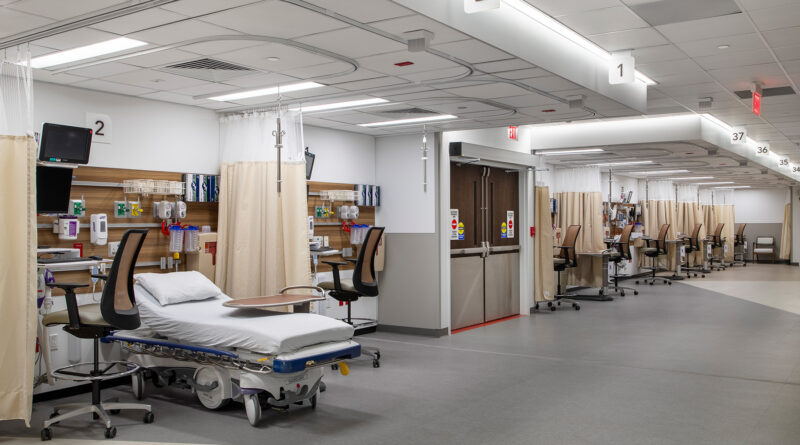Integrating Technology to Optimize Patient and Staff Experience
By Taw North
It’s an inescapable discussion no matter who you are or what industry you work in. Artificial intelligence is the talk of every business, and with each conversation, its reach grows further with promises to reshape how we live, learn and work.
In healthcare, such talk is not new, even if the volume seems to be louder now. In 2019, the Canadian College of Health Leaders produced a paper examining the role of AI technologies in healthcare, looking at machine learning, natural language processing and robotics as well as considerations for development and deployment. A key point the authors noted in the paper: “The key in human-machine partnership is to keep the delicate balance between the types of care we value and the levels of automation that AI technologies offer.”
Fast-forward five years, and the integration of forward-looking technology has only relatively progressed. In a 2024 white paper circulated by the Health Facility Management Association and authored by Microsoft, only 6% of healthcare organizations have a generative AI strategy, although, the authors note, around 50% are examining such a strategy.
The fact is that technological advances in healthcare coupled with staffing challenges in the profession have accelerated the conversations about AI adoption. However, that fact is balanced by the realities of technology: It comes with a significant cost, it requires integration, and, many times, it’s a still-to-be-qualified solution outside of the sandbox.
Technology is and has always been attractive to care providers. Integrating and optimizing hospital technology systems to share information can improve communication and collaboration among staff, enhancing efficiency and improving staff retention. By extension, this kind of integration can also improve the patient experience.
Yet, at a time when healthcare finances are under pressure from more demand and stagnant (if not falling) reimbursement rates, the high price to invest in top-performing technology systems makes adoption challenging, at best, and a non-starter, at worst.
Technology systems’ enhancement to hospital performance is proven, with use cases showing savings in labor costs, improvement to staff retention and increases in patient-satisfaction scores. For organizations looking to leverage technology to support their facility’s needs into the future, examining a strategy, anticipating the challenges, having a plan for implementation and stakeholder engagement, and knowing what to measure after implementation can help leaders put an analytical lens to technology optimization.
Understanding the path forward
For organizational leaders, deciding where to put investments has always been a tug-of-war between current needs and future opportunities as well as a choice between what can advance patient care versus what can make the operation more efficient and sustainable.
Historically speaking, the integration of technology systems — such as an interactive patient system, building control system, nurse call system with real-time location monitoring, mobile phones and cameras in patient rooms — has always been challenging. These systems need to talk to each other and share information, but many times planning obstacles or unintentionally misaligned budgets have left these systems separated and sub-optimized.

The decision on whether to invest in systems and how much is not a black-and-white issue. Looking at the challenges, many times it comes down to a determination guided by the culture of an organization and identifying the goals of the facility and how they want to use the technology.
Once a decision is made to move forward, anticipating a return-on-investment can help right-size the investment to manage the expectations of a system’s performance. A limited budget can quash even the best of intentions owing to the rising costs of technology. Knowing what the upfront costs are along with operational costs, organizations can align expenditure decisions with their facility’s mission and vision.
Cybersecurity is also a cost that must be factored into any technology decisions. Processes and policies have become more rigorous as a result of so many potential vulnerabilities. Cybersecurity reviews, particularly if the system is connected to outside systems or the cloud, is standard protocol now.
The biggest challenge could be thinking five years ahead rather than the current state. Seeing technology beyond what it enables in the moment is often the biggest blind spot organizations experience. Predictions in healthcare are that AI will continue to expand capabilities within the next decade. Developing a Technology Roadmap is critical to the planning process. Designing a system to support future integration puts an organization on a path that can mitigate extensive redesigns and associated costs when those technologies become more widely available.
Implementation and adoption
Integrating and optimizing technology systems is both a logistical challenge as well as a cultural one. On the latter aspect, what organizations can’t overlook is that, for all the advancement technology will bring in capabilities and efficiencies, it’s still a complement to the humans delivering and experiencing the care. As the Canadian researchers noted from their American counterparts in the American Medical Association, “…the role of AI in healthcare is ‘augmented intelligence.’”
Simply, technology is there to enhance human intelligence and performance, not replace it.
Through this lens, setting the appropriate expectation for a return on investment can help vested parties in an organization speed the acceptance and adoption of new technology systems. Clinical and operational use cases, complete with data model overlays, are key to setting those expectations.
From there, a strong change management program can reduce the obstacles to adoption by engaging vested parties early and documenting processes changes in detail to help users smoothly transition activities to the new systems. Successful change management programs go beyond training all staff to empowering superusers who can demonstrate competently how processes are improved by the assistive technology and advocate for the benefits of the new system.

Like a construction project with a project manager, a change management program requires a program officer who can manage the change readiness and documented knowledge transfer for successful technology adoption.
On the technical side, implementation begins with an analysis of the current system to understand how it’s utilized and what its capabilities are. Then a use-case analysis is created to identify a system that is relevant and effective for an organization. Systems that serve multiple departments must be more broadly applicable and will have higher priority.
A pilot program to test the system and work out issues is followed by a roll out phase, training and implementation.
The roll-out phase should be intentional and well planned. Self-imposed deadlines, while maintaining a schedule, can lead to oversights in implementation and testing. It is essential to have realistic deadlines and make sure the work pace matches the pace that people will be willing to adopt the technology.
As important, a technology steering committee is essential as a decision-making body to oversee any changes to the technology program. Usually guided by a charter, the steering committee can bring a logical assessment to any adjustments needed to implement a successful system.
Measuring the right data
The data model overlays that manage the expectation for ROI do so by providing data insights into operations and where those operations can be improved. Overlays of a facility and patient throughput can identify areas to optimize staffing and space efficiency or identify bottlenecks. Is the issue a shortage of staff or are more patient care rooms needed to improve throughput, for example.
Integration of technology systems works because it gathers data from multiple systems that can be used to enhance patient satisfaction and staff performance. For example, it can identify the time it takes from entry to registration, being seen in the emergency department, to getting admitted to an inpatient bed. Data can be gathered on the time it takes for rooming a patient, consultation with a provider, treatment and discharge.
Most importantly, integration of the system can improve communications and collaboration along the care team spectrum, improving not only the patient experience but also elevating staff satisfaction.
With the technology steering committee, organizations can look at systems integration through holistic planning and oversight for the analysis, pilot programming, testing and continuous improvement.
While organizations debate how AI will be incorporated into care and operations, the fact is that AI is just one component of a comprehensive technology strategy. From wireless communication systems to patient engagement and remote sensors, technology requires an integrated approach that considers both the hardware and software needs to fit the culture of an organization.
Cost is cost, and while the systems can require a significant investment, the returns can justify what organizations want to achieve. For organizations willing to innovate, working with vendors to beta test systems can put organizations well ahead in leveraging forward-looking technology to improve care delivery.
Integrating hospital technology that addresses present-day needs while accommodating future developments requires a phased approach based on qualitative data as well as input from multiple parties. By implementing a holistic multi-step approach that includes vendors, superusers, and hands-on training along with considerations such as cybersecurity, facility leaders can anticipate future technology integration that makes the investment worthwhile.
Taw North, RCDD, LEED AP, is principal and regional director with TLC Engineering Solutions. He can be reached at taw.north@tlc-eng.com.

